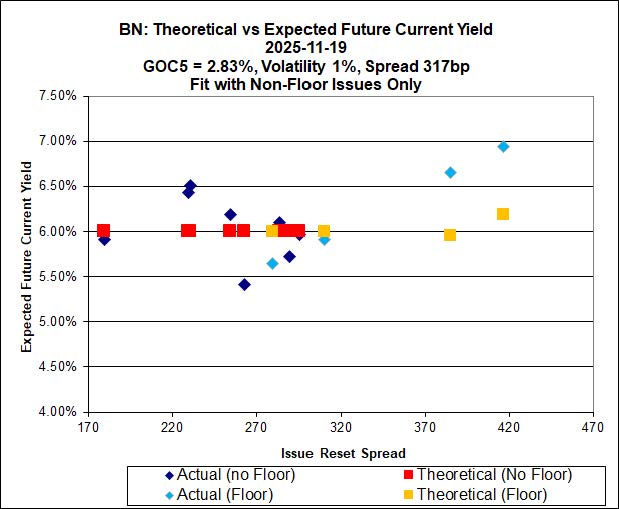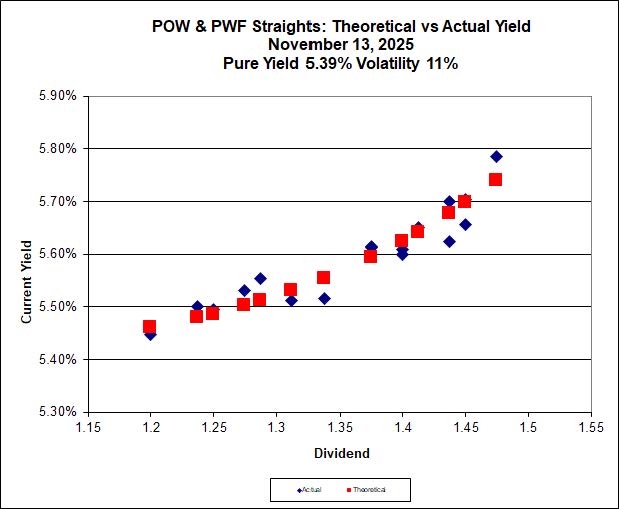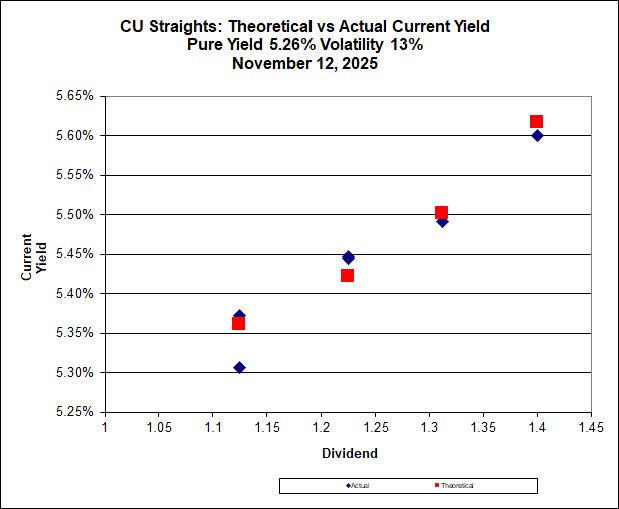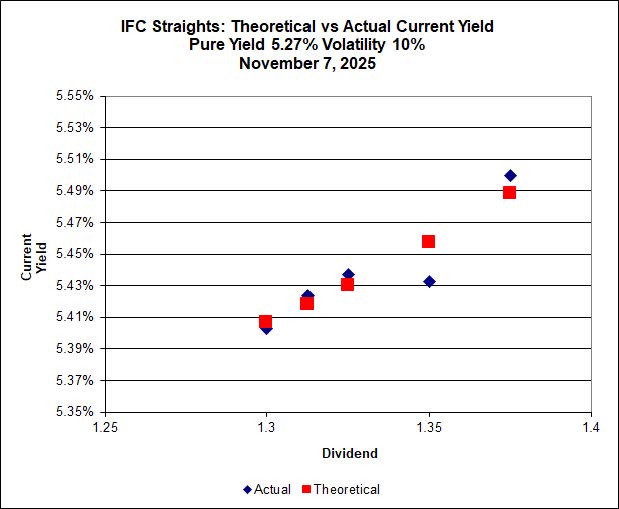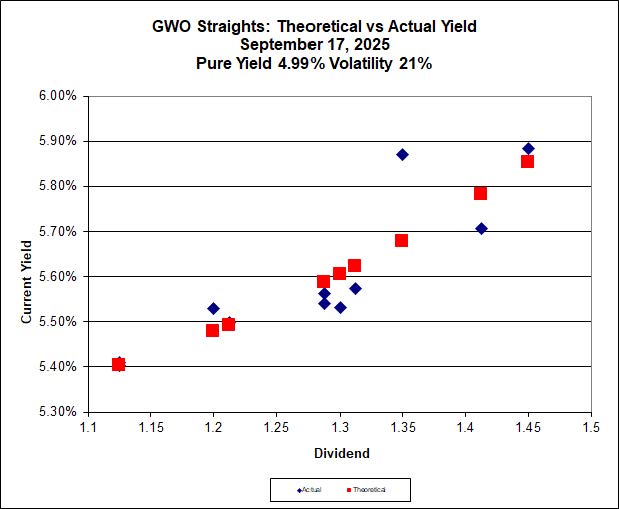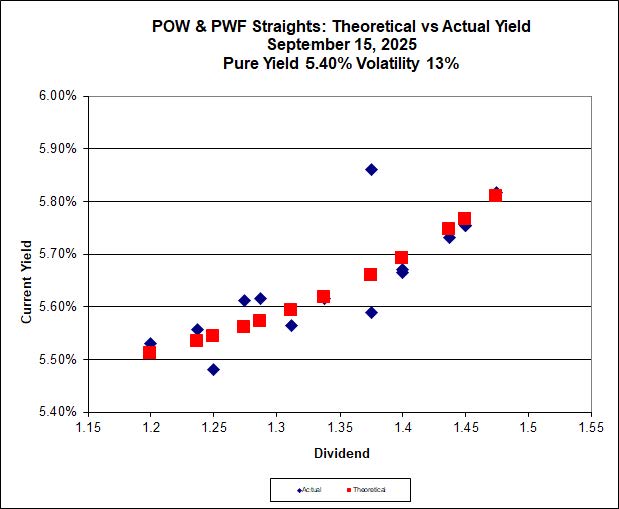On 2024-1-10, Middlefield Limited announced:
that [International Clean Power Dividend Fund (“CLP”)] intends to merge (the “Merger”) into Infrastructure Dividend Split Corp. (“Infrastructure Split Corp.”), a split share corporation to be formed in connection with the Merger, with unitholders of CLP becoming Class A shareholders of Infrastructure Split Corp. In conjunction with the Merger, Infrastructure Split Corp. plans to undertake an offering of a number of preferred shares (the “Preferred Shares”) approximately equal to the number of Class A shares that are outstanding immediately following the Merger. Terms of the Preferred Shares will be announced at least 60 days prior to the Preferred Share offering and will be included in an information circular distributed to unitholders in advance of the Meeting (as defined below).
The investment strategy of Infrastructure Dividend Split Corp. will be to invest in an actively managed portfolio of approximately 15 dividend-paying issuers operating in the infrastructure sector that Middlefield Capital Corporation (the “Advisor”), the investment advisor of CLP and Infrastructure Split Corp., believes are currently undervalued and well-positioned to benefit from the Advisor’s outlook for a gradual reduction in interest rates, the continuation of global decarbonization, and favourable demographics (such as growing middle class and urbanization).
Infrastructure Dividend Split Corp.’s investment objectives will be to provide:
Holders of Class A shares with:
(i) non-cumulative monthly cash distributions; and
(ii) the opportunity for capital appreciation through exposure to Infrastructure Dividend Split Corp.’s portfolio; and
Holders of Preferred shares with:
(i) fixed cumulative preferential quarterly cash distributions; and
(ii) a return of the original issue price of $10.00 to holders upon maturity.
Infrastructure Split Corp.’s investment objectives and strategies will differ from those of CLP, including as a result of Infrastructure Split Corp.’s investment objectives and strategies not referring to environmental, social, and governance (“ESG”) considerations. Infrastructure Split Corp. will continue to consider ESG factors alongside other investment characteristics when selecting issuers for inclusion in its portfolio, but will not be constrained by such considerations. The Manager believes that the new objectives and strategies will provide Infrastructure Split Corp. with greater flexibility and a broader investment universe than those of CLP, which the Manager believes will ultimately lead to better returns for investors.
Split share corporations are unique investment vehicles that provide opportunities for both conservative and more aggressive investors. Further details regarding the operation of split share corporations can be found at https://middlefield.com/split-share-primer/.
Pursuant to the Merger, Infrastructure Split Corp. will issue Class A shares to CLP’s unitholders with a value of $15 per Class A Share. The initial target distribution yield for the Class A Shares will be 10% per annum based on the notional $15 issue price (or $0.125 per month or $1.50 per annum). On a relative basis after accounting for the exchange ratio as of January 9, 2024, unitholders can expect to see their gross monthly distributions increase by approximately 35% post Merger. The management fee of Infrastructure Split Corp. will be 1.10% per annum, a reduction from the 1.25% per annum management fee of CLP.
A special meeting of unitholders of CLP will be held on or about April 16, 2024, at which unitholders of CLP as of a record date to be determined will be asked to approve the Merger. Further details of the meeting will be provided in an information circular to be distributed to unitholders of CLP as of the record date in advance of the special meeting. If approved, the Merger is expected to be completed on or about April 18, 2024 (the “Effective Date”). All costs of the Merger and the special meeting will be borne by the Manager.
The Merger will not be effected on a tax-deferred roll-over basis and, as such, will be considered a taxable event for investors that may result in capital losses or gains becoming realized. The Merger will be completed at an exchange ratio calculated as the net asset value per unit of CLP determined as at the close of trading on the TSX on the business day immediately prior to the Effective Date divided by $15.00. Pursuant to the Merger, Infrastructure Split Corp. will assume the liabilities of CLP and will issue Class A Shares of Infrastructure Split Corp., based on the exchange ratio, in satisfaction of the purchase price for the assets of CLP.
The Manager believes that the Merger will benefit unitholders of CLP. Class A Shares of split share corporations have demonstrated the potential to trade closer to, and in some cases even above, their fund’s net asset value per share. If the shares trade at or above net asset value, the Infrastructure Split Corp. could position itself to raise additional capital, thereby leading to a larger asset base, improved liquidity and lower overall cost.
The unitholders of CLP who do not wish to participate in the Merger can sell their units in the market or tender them for a redemption prior to the Merger. In order to provide unitholders with more time to consider their options, the Manager has extended the redemption notice period to Thursday, February 29, 2024. Unitholders should be aware that by tendering units for redemption they will be exposed to pricing risk for the period between the deadline to tender units and the effective date of the redemption, being March 28, 2024, and that redemption proceeds equal to the net asset value per unit of CLP as of such redemption, less any costs associated with the redemption, will be paid sometime in April 2024.
The Merger remains subject to the satisfaction of all regulatory requirements and customary closing conditions, including the approval to list the Infrastructure Split Corp. on a stock exchange, and securities regulatory approval of the offering of preferred shares by Infrastructure Split Corp., if applicable.
I love the way they tout the idea that “unitholders can expect to see their gross monthly distributions increase by approximately 35% post Merger”. Sure, Middlefield. And all this money is magically appearing out of nowhere, right?
The mutual fund that is to be converted hasn’t been doing very well, according to the 2023 Year-end factsheet. Not surprising, really, given the movement in interest rates since inception, and performance is at least in the same ballpark as the designated benchmark (a 50-50 mix of the S&P Global 1200 Utilities Sector GICS Level 1 index and the S&P Global Clean Energy Net Total Return Index).
DBRS has blessed the proposed preferred shares with a provisional Pfd-3(high) rating:
DBRS Limited (Morningstar DBRS) assigned a provisional credit rating of Pfd-3 (high) to the Preferred Shares to be issued by Infrastructure Dividend Split Corp. (the Company). Middlefield Limited will act as the manager of the Company (the Manager).
The Company intends to acquire pursuant to an asset purchase agreement (the CLP transaction), the investment portfolio of International Clean Power Dividend Fund (CLP), a non-redeemable investment fund structured as a trust and managed by the Manager. At the time of closing of the CLP transaction, the investment portfolio of CLP will comprise securities that are consistent with the Company’s investment strategy. In exchange for the assets of CLP, the Company will issue Class A Shares that will be distributed by CLP to its former unitholders and CLP will be wound up. Closing of the CLP transaction will be conditional upon the approval of CLP unitholders, which will be sought at a meeting to be held on or about May 1, 2024.
In conjunction with the CLP transaction, the Company will offer Preferred Shares in a number approximately equal to the number of Class A Shares that will be outstanding immediately following the closing of the CLP transaction. The Company intends to issue Preferred Shares and Class A Shares with an issue price per Preferred Share and per Class A Share that will result in 40% of the gross proceeds coming from the issuance of the Preferred Shares and the remaining 60% of the gross proceeds coming from the issuance of the Class A Shares. Following the closing of the CLP transaction and the initial offering of Preferred Shares, the Company may undertake further offerings of Preferred Shares and Class A Shares only on the basis that an equal number of Preferred Shares and Class A Shares will be outstanding at all material times. The Preferred Shares will mature on April 30, 2029 (Maturity Date). The term of the Company may be extended beyond the Maturity Date for additional terms of five years each as determined by the Company’s board of directors.
The Company will use the net proceeds raised from the sale of the Preferred Shares to invest in securities of infrastructure issuers in accordance with the Company’s investment objectives, strategy, and restrictions.
The investment strategy of the Company is to invest in an actively managed portfolio (the Portfolio) comprising approximately 15 dividend paying securities of issuers operating in the infrastructure sector. The Company will invest in issuers the Advisor (Middlefield Capital Corporation) believes are undervalued and well-positioned to benefit from the Advisor’s outlook for a gradual reduction in interest rates, the continuation of global decarbonization, and favourable demographics (the Infrastructure Issuers). The Company is restricted from having for a period of more than 30 consecutive days: (1) less than 75% of the value of the total assets of the Company (excluding cash and cash equivalents) comprising the securities of Infrastructure Issuers, (2) more than 25% of the value of the total assets of the Company (excluding cash and cash equivalents) comprising securities of issuers having a market capitalization of less than CAD$1 billion, and (3) more than 15% the value of the total assets of the Company (excluding cash and cash equivalents) comprising securities of issuers from countries that meet MSCI’s definition of emerging market country. The Portfolio may include securities denominated in currencies other than the Canadian dollar, which may expose the Company to foreign exchange risk. However, the Company initially intends to hedge the majority of the exposure back to the Canadian dollar.
The Company intends to initially invest in a Portfolio consisting of equity securities from the following 15 investment-grade Infrastructure Issuers: Brookfield Infrastructure Corp, Brookfield Renewable Corp, Capital Power Corp, Crown Castle Inc, CT REIT, Enbridge Inc, Gibson Energy Inc, National Grid plc, NextEra Energy Inc, Northland Power Inc, SmartCentres, Southern Company, SSE plc, TC Energy Corp, and Union Pacific Corp.
The Preferred Shares will be entitled to receive fixed cumulative preferential quarterly cash distributions of $0.18 per share, representing a 7.2% per annum return on the issue price of $10.00. Holders of the Class A Shares will initially receive regular monthly noncumulative distributions targeted to be 10% per annum based on the initial issue price of $15.00. The Company intends to increase or decrease from time to time, the targeted monthly distribution amount to the Class A Shares, to reflect any increase or decrease to the Company’s available income. No monthly distributions to the Class A Shares will be made if (1) distributions to the Preferred Shares are in arrears or (2) in respect of a cash distribution, the net asset value (NAV) of the Company falls below 1.5 times the principal amount of the outstanding Preferred Shares. To supplement Portfolio income, the Manager may write covered call options on all or a portion of the shares held in the Portfolio, engage in securities lending, and rely on realized capital gains.
Based on the initial asset coverage of 2.5x, the net asset value of the Company would have to fall by approximately 59% for the holders of the Preferred Shares to be in a loss position. The initial dividend coverage ratio is above 1.0 times (x).
The Company may establish a loan facility or prime brokerage facility (the Loan Facility) for working capital purposes, with the maximum amount of 5% of the NAV of the Company. The Company may pledge the Portfolio securities as collateral for amounts borrowed under the loan facility. The Preferred Shares will be subordinated to any indebtedness under the Loan Facility.
The Company may issue an unlimited number of Preferred Shares, Class A Shares, and Class M Shares. The Preferred Shares rank in priority to the Class A Shares with respect to the payment of distributions and the repayment of capital on the dissolution, liquidation, or winding-up of the Company. The Class A Shares rank subsequent to the Preferred Shares, with respect to distributions and the repayment of capital on the dissolution, liquidation, or winding-up of the Company. The Class M Shares rank subsequent to both the Preferred Shares and the Class A Shares. There are 100 Class M Shares issued and outstanding at an issue price of $0.10 per share, and no additional Class M Shares can be issued until all the Class A Shares and Preferred Shares have been retracted, redeemed, or purchased for cancellation. The holders of the Class M Shares are not entitled to receive dividends.
On maturity, the holders of the Preferred Shares will be entitled to the value of the Portfolio up to the face value of the Preferred Shares and any accrued and unpaid dividends.
The Pfd-3 (high) credit rating reflects (1) the level of downside protection available to holders of the Preferred Shares, (2) the initial Portfolio quality and underlying securities correlation, (3) the effect of stated distributions to the Class A Shares, and (4) term to maturity of the Preferred Shares.
The main constraints to the provisional credit rating are the following:
(1) The downside protection available to holders of the Preferred Shares will depend on the value of the securities held in the Portfolio.
(2) Volatility of price and changes in the dividend policies of the underlying issuers may result in significant reductions in interest coverage or downside protection from time to time.
(3) Reliance on the Manager to generate additional yield on the Portfolio to meet distributions and trust expenses, without having to liquidate portfolio securities.
(4) Stated monthly distributions on the Class A Shares, which will create a grind on the Portfolio mitigated by an asset coverage test of 1.5x, which ensures sufficient levels of downside protection to the holders of the Preferred Shares.
Morningstar DBRS’ credit rating on the Preferred Shares addresses the credit risk associated with the identified financial obligations in accordance with the relevant transaction documents. The associated financial obligations are the fixed cumulative preferential quarterly cash distributions and the return of the original issue price to holders of the Preferred Shares on the maturity date.
Morningstar DBRS’ credit rating does not address non-payment risk associated with contractual payment obligations contemplated in the applicable transaction documents that are not financial obligations.
Morningstar DBRS’ long-term credit ratings provide opinions on risk of default. Morningstar DBRS considers risk of default to be the risk that an issuer will fail to satisfy the financial obligations in accordance with the terms under which a long-term obligation has been issued. The Morningstar DBRS short-term debt rating scale provides an opinion on the risk that an issuer will not meet its short-term financial obligations in a timely manner.
So, we’ll see. This issue could start off with a substantial float, if enough unitholders convert to Capital Units, which would be nice … for potential preferred share purchasers, anyway!
